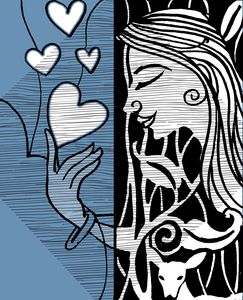The session at the Jaipur Lit Fest 2019 that I was most looking forward to was my interaction with Chitra Banerjee Divakaruni at the launch of her latest book, The Forest of Enchantments. I have, for long, admired her scholarship and eloquence. When I received the advance copy, I noted the dedication: To my three men—Murthy, Anand and Abhay... for teaching me love. I started reading the book, intrigued by those lines. It had never occurred to me that love could be ‘taught’. I had always believed that love has to be felt. Instinctively. There was clearly a lot to learn from this erudite lady (PhD in English, Berkeley) who teaches creative writing at the University of Houston. I met her husband for a few minutes before our session, and was moved by his total, undisguised involvement and pride in his wife. She, in turn, was attentive and loving towards one of the three men who taught her love—Murthy.
Her adoring fans greeted her arrival on stage with a loud applause. Chitra is used to it. Ten years after The Palace of Illusions became a bestseller, she was ready with another captivating tale. After Draupadi, it was Sita’s turn for a literary interpretation. Chitra’s first person narrative takes a while to get used to. The conversational passages in which Sita, one of India’s most revered mythological characters, chats with her husband Ram, using contemporary idioms, can lead to a severe disconnect, as it did for me. But, after the first 20 pages, I was riveted. I could ‘hear’ Sita’s voice as she moved seamlessly from being a spirited and beautiful princess of Mithila to assuming responsibility as Ram’s dutiful wife and queen of Ayodhya, who joined her husband and brother-in-law Laxman during their 14-year exile in the forest.
The forest is as much a star here as Sita, and yes, it is filled with enchantments. Chitra’s descriptive prose about Sita getting accustomed to her new life, communing easily with birds and animals, in a magical, intuitive manner, draws readers into her many dilemmas and disappointments. As Chitra read out a few passages, her rapt audience gobbled up each line and word. The questions that followed were informed and fascinating. She dealt with them like a competent teacher, perhaps anticipating a few of the more obvious ones and nimbly dodging the more politically loaded queries.
Dressed in a black silk sari, Chitra cut a striking figure, delving confidently into the ‘Sita syndrome’ (my words, not hers) and the final act of hers (returning to Mother Earth voluntarily, instead of facing one more agni pariksha [trial by fire]). The Ramayan has been a source of much debate and discussion in recent times, especially Sita’s complex decisions. Chitra has invested years of deep study, researching and discovering ‘her’ Sita. She referred to Sita’s dilemma as a #MeToo moment, given its boldness. The readers responded enthusiastically to the clever analogy, and related to the many sexist issues in the telling of Sita’s story. Chitra considers the Ramayan “one of the greatest and most tragic love stories—not just in our Indian culture but in the world”.
In my reading of the book, I had felt that Chitra’s representation of Ravana was most intriguing. I asked if Sita was indeed attracted to his virile personality and extensive learning. Chitra did not fall for it and deftly deflected the question. Given the dramatic twist at the end of her narrative, I guess that was the smarter route to take. Chitra ends the story on a poetic, philosophical note, with Sita forgiving Ram and reminding him that love “doesn’t measure who is worthy and who is not. It is like the ocean. Unfathomable. Astonishing. Measureless.’’ Who can disagree?
www.shobaade.blogspot.com


